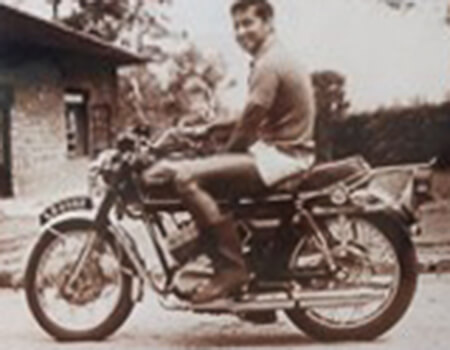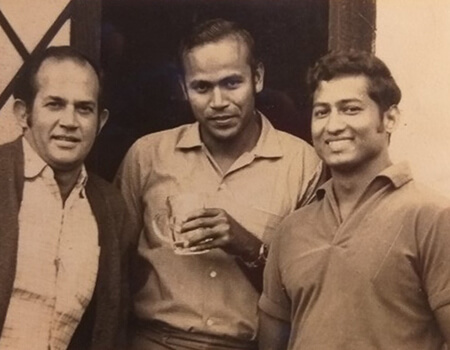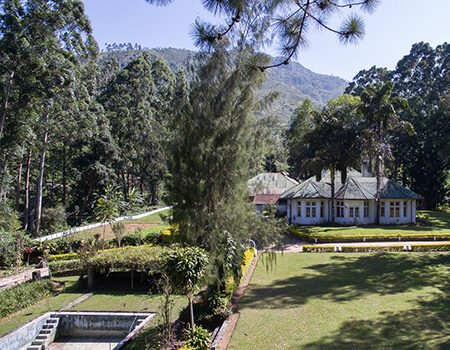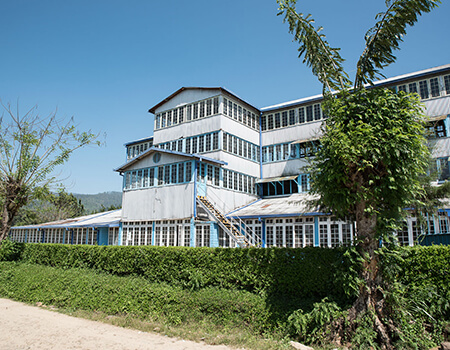
Please Share your Email if you Wish to Receive the Golden Tips & Tales Newsletter from History of Ceylon Tea Website





(Originally published in the Thomiana Newsletter and reproduced with kind permission of the author)
Retrospect provides objectivity. What one has done in one’s lifetime is best viewed from afar.
A planter’s workday may have not changed substantially, since the old coffee days of the mid-19th century, till perhaps the 1980s. The routine was linked to an agricultural calendar, consisting of activities to be done on a daily, weekly, monthly and an annual basis; repetitive but comforting as, on the first day of the year, you had a clear idea of what needed to be done the next day, as well as at the end of the year. The activity programme was driven by predictable weather patterns and changes to the routine corresponded to variations in the weather. My era in planting, which was before Climate Change had been thought of, both weather and climate were reasonably predictable, and the routines were consistent, year on year.
To describe a planter’s workday to a present-day audience, I need to relate it to my time as a planter, which commenced in 1968. Many aspects of the plantation management environment have changed dramatically since then but what the tea bush, or the rubber tree needs, has remained basically the same. What has undergone a gradual evolution and change is the degree of importance attached to those requirements.
To those unfamiliar with planting, the best introduction to a planter’s life would be a brief description of the workday of the “Creeper” (trainee planter), for which I shall draw entirely from personal experience and knowledge. The creeping period provides a very reliable definition of a planter’s subsequent professional life.
My training as a planter was on Gordon Estate, Udapussellawa, a tea property owned by a prestigious Sterling Company, Standard Tea, managed by George Steuart & Co. My mentor was its then Superintendent, Maurice Koelmeyer.
My introduction to a planter’s daily regime began the day after my arrival on the estate, with Maurice giving me a guided tour of the estate in his car. To the best of my recollection, that was also my last field round in a vehicle, on Gordon. For the next six months, till my training ended, I walked. Maurice also told me, categorically, that whilst on my field rounds, he did not expect me to hitch rides in the leaf-lorry. The underpinning logic then – irrefutable in today’s context as well – was that walking facilitated observation, a critical aspect of the effective learning and supervision process.
The creeping period is a harsh testing time. Initially conceived by the early British planters, many of whom were retired military men, it was a boot-camp regime calculated to test both the physical and mental fortitude of the young trainee. The creeper was not permitted to achieve objectives through easy, efficient means and difficulties and obstructions were, seemingly, deliberately introduced. Most of the local, senior superintendents of my day, faithfully emulated this system set in place by their British forerunners.
My “creeping period” on Gordon was a perfect example of this concept. My training ground was Gracelyn Division, a precipitous, unfriendly segment of land, much of it slab rock, with low-yielding China Jat tea.
Access to it was either along a lengthy, winding cart-road or by an arduous climb up steep, slippery foot-paths and narrow steps. The latter, though much more tiring than the cart-road, was quicker, but still took me the better part of an hour. On most days, I did this trip four times a day, back and forth, the first one at dawn, to attend morning muster. Maurice could have sent me to the Gordon division muster ground, ten minutes brisk walk from the bungalow, but he too stayed true to tradition. Obviously, this type of training was calculated to impress on the novice planter, the need to handle adversity and physical hardship from the very inception.
The mornings were spent largely in fields where agricultural and land management work were in progress, whilst the post-lunch session was entirely in the plucking fields. As deemed by my trainer, daily, I marked the Check-Roll book at evening muster. After dinner, or early morning the next day, before leaving for morning muster, I would total the Check-Roll book and ensure that the labour amalgamation for the previous day was properly accounted for. In addition, on a daily basis, I personally weighed green leaf at randomly selected weighing points.
My time, both as a trainee and as a young SD (Sinna Dorai - Assistant Manager), was years before the invention of the pocket calculator and the neural gymnastics required for the repetitive addition of rows of numbers used to drive me insane. Largely on account of a congenital mental incapacity for mathematics, the daily Check-Roll computation was, without doubt, the most demanding part of my training period.
In addition to the introduction to wide-ranging aspects of the agricultural management of tea, I was encouraged to learn the basics of tea manufacture. The latter required regular visits to the factory during “night” manufacture, which was after the day’s work was done. Reading back-copies of the Tea Research Institute, Quarterly publications was also mandatory, and Maurice used to question me, on a daily basis, on what I had learned, or observed, during the day.
Another aspect of the training programme was the rapid acquisition of spoken Tamil. The plantation workers, especially in the up-country estates, were almost entirely of Indian origin and, unlike today, very rarely spoke Sinhala. Communication was entirely in their language and early proficiency in Tamil was a non-negotiable requirement. The importance attributed to competence in Tamil was such that the first, mandatory qualifying exam a planter had to face was in spoken Tamil, preceding testing in Tea Manufacture and Plantation Accounting.
The rigour of the training regime I went through was the norm then, right across the plantation sector. Earlier, when the plantation sector was dominated by the British, it had been, reportedly, even more demanding. Maurice, apart from his non-negotiable insistence on the professional aspects of the training programme and its conditions, treated me with much kindness and consideration. My training period, with his charming wife Bella ensuring the comfort of my living conditions, was a very happy time.
On successful completion of the creeping period, as a young SD, the work routine did not change significantly, except for one key factor. The former creeper was now operationally responsible for every aspect of work in the divisions in his charge. Unlike in the creeping period though, an SD paid for the mistakes he made! The consequences of either inadequacy or incompetence could be costly, even leading to loss of employment under an exacting PD. Such incidents were not uncommon in my day.
If I were to believe that there would be relief from the onerous responsibility of check-roll marking, on becoming an SD, I was soon to be disillusioned. More than a year after my training period, when I was SD on St. Leonards, Halgranoya, my then Superintendent, Chris Mossop, decided that I should do the Coneygar Division Check Roll on my own, for three months and, at the end of each month, compute the labour pay as well. Fifty years later, I must confess that I cheated a bit. Whilst I marked the check roll daily, I got a junior clerk in the estate office to do the month-end labour pay computation.
For the young SD, field work supervision was a key element, the morning spent in fields which were being weeded, drained, forked or where other land management work was taking place. The supervision of tea field pruning, unarguably the most important of all field work on an estate, was given prime attention as and when such work took place. The SD was expected to inspect each row of pruned bushes, each day, and that meant spending the greater part of the day on the particular field.
Fertilizer applications in tea fields, which took place once every three to four months, was considered so important that the SD was expected to follow the fertilizer spreading workers from tea row to tea row, ensuring even distribution. Added to field duties would be monthly checking of all stocks on the property, both in the divisional and main stores. There would also be the monthly comprehensive verification of all tea stocks, which involved the weighing and recording of every single gram of tea in the factory, and at least one random check in addition.
As an SD on Sheen estate, Pundaluoya, in the early 1970s, under its Superintendent, Derrick Wickremesinghe, I learnt, at first hand, what it was to deliver on the expectations of a very exacting manager. His insistence on excellence challenged your competence on a daily basis. All of the work routines described in the preceding passages had to be implemented, in this instance, with clock-work precision, whilst maintaining a pre-determined work quality; a serious test of one’s commitment to supervision.
Wickremesinghe also insisted that each SD should attend night manufacture twice a week, following the process for a minimum of three batches of leaf, from rolling to firing. The relevant report had to be on his office table by 7.30 am. Immediately on submission of the report, we had breakfast and strode off to the field. That we had spent the better part of the night in the factory, at the end of a hard day in the field, did not entitle us to any rest the next day!
The estate accounts had to be verified monthly, with every book of record being examined in sequence, beginning with the relevant divisional books. I and the Senior-SD (Asoka Herat, old Trinitian) did this together, generally starting on a Friday afternoon and finishing by Sunday evening. All such verifications, including stocks checks, had to be carried out after normal working hours, which meant starting the assignments around 6 pm. The unspoken but clear message was that the hours between 6 am and 6 pm were meant for field work.
An important issue to bear in mind, when comparing the routine of a planter in my day, and that of the planter of today, is that mine was the period before computerization and the digitalization of information. The data which is available to the planter of today, at the click of a mouse, had to be extricated laboriously in my day, manually, by reference to a multitude of voluminous physical books of record.
Another important aspect was the maintenance of work progress and the relevant expenditure records; weeding, draining, forking, fertilizer programme implementation, field history books, individual field yield record books, tea, timber/shade tree/fuel-wood, nursery management records which, on Sheen, had to be maintained in the SD’s own handwriting. Such manual tabulation introduced a repetitive element and the overlapping of information, inevitable in a system as data-driven as plantation management. However, the personal responsibility for records management ensured that the diligent SD had, at his fingertips, access to all the information he needed to make intelligent management decisions; or to respond effectively to testing questions thrown at him at unguarded moments, by a difficult Superintendent, or a Visiting Agent.
The Muster Diary, one book per division, which was updated daily and sent to the PD every morning, was a capsule record of every activity which had taken place on the relevant division, up to the last minute of the previous day. As an SD, I would check this book minutely, either before going to bed, or before leaving for muster early the next morning, a routine duplicated then, on hundreds of estates across the country. The consequences of misreporting or omissions could be dire, for both the SD and the Field Officer of the division.
The “Labour Day” then was also an important item in the work routine. Individual workers, often accompanied by the divisional “Talaiver” (spokesman of the relevant trade union), presented to the SD various issues, generally personal needs or grievances, which required resolution. Those which required the superintendent’s authority for a solution were referred to him, for his monthly labour day. The issues tabled, and the solutions provided, were faithfully recorded in the relevant “Labour Diaries”. These were, then, sacrosanct records of important commitments from both the worker and the management. On Sheen there were two divisional labour days each month.
The management protocols which I have described above, using personal experience as examples were widely followed on all plantations, particularly those managed by Agency Houses in the pre-nationalization era, especially on well-run plantations led by competent and exacting Superintendents. The latter qualities were, invariably, synonymous.
As a superintendent, or manager (PD – Periya Dorai) of an estate, there was a primary, and important difference in the daily routine from that of the SD. The PD had the liberty of establishing his own routine, according to his own sense of priorities. Generally, most PD’s would start the day with an early morning visit to the factory, to taste the tea from the previous night’s manufacture , followed by breakfast and then a session in the office, evaluating the previous day’s work by examining the field diaries, normally delivered to the estate office in the morning. There would also be a mid-morning field round, often lasting till lunch time.
The afternoon session would again be in the office, generally dealing with correspondence from a multiplicity of external agencies, and discussions and actions related to estate accounts and estate expenditure. The Cost of Production (COP) was a sacred benchmark which all diligent estate managers kept an eye on, on a daily basis.
At the end of the day, another trip to the factory, perhaps to check on green leaf volumes, condition thereof and, also, to discuss with the Head Factory Officer, any adjustments to the manufacturing process as may be necessary. Such discussions would also address reports from the brokers on tea samples already dispatched and may result in adjustments to the manufacturing process. Such variations may be either to correct reported deficiencies in the final product, or a response to a sudden change in tea market demands. In addition, there was the almost daily tasting of tea samples, both from one’s own estate and from other estates in close proximity. Weather fluctuations, tea market volatility, green leaf standards and volumes, factory machinery issues, all impacted either positively or negatively on the final product and, therefore, had to be evaluated on a daily basis and countered with appropriate technical corrections in the manufacturing process.
Sandwiched into the daily routine would be discussions with contractors, engineers, agricultural advisers and other service providers, invariably handled personally by the estate manager. These did not take place every day but were important engagements.
I have been associated with the plantation industry, initially from the Agency House era, through the transition consequent to nationalization, State ownership and management, and then the re-privatization or the Regional Plantation Company (RPC) era, which commenced in 1992. These changes have resulted in necessary transformations in the planter’s work routine as well. As an active participant of that evolutionary process till retirement a couple of months ago, I am able to speak with reasonable authority on its progression.
At the beginning of this narrative, I spoke of the comforting sameness of the planter’s daily routine, in my day. That was a result of a combination of factors; reliable weather patterns and a very insular plantation environment which was, to a very large extent, under the planter’s control. It was an era when the planter could either successfully resist or reject, or effectively manage, intrusions into his area of authority. Then it was even possible to disregard changes in the external society and to carry on at one’s will, in what used to be the relatively impermeable plantation microcosm.
However, today, the RPC plantation environment is highly externalized and is interconnected with the immediate mainstream society. Intrusions, both legitimate and illegal, are frequent. Much of it, driven by a combination of instantaneous communication, ambiguity in the interpretation of ownership and authority and limitations on the exercise of personal judgement, are frequent and, often, unmanageable. As a result, the agenda of today’s planter is often written elsewhere, and he is denied the luxury of planning on the basis of personal prioritization. Those factors have brought about a complete change in the daily routine of the planter of today and, try as I might, I cannot think of many consequent advantages. Evolution quite often brings about complexity but is not necessarily beneficial.
Anura Gunasekera (STC, Mt. Lavinia ’55-’66) has served in the Plantation Industry for over 50 years, initially, as a Planter in various estates managed by George Steuarts Agency and the JEDB. On leaving active planting, he re-joined GS&Co and was, sequentially, the head of the Wekande Mills Tea warehousing and blending operation, the head of the GS&CO Administration and Human Resources and, also, consultant to Kotagala Plantations. Subsequently, with the Dipped Products Group of Hayleys (1995-2011), was attached to Kelani Valley Plantations, retiring as Director, KVPL and DPL Plantations. Post-retirement he joined the MJF Group and eventually retired in 2020, as Director/CEO, Kahawatte Plantations.
Comments
(In keeping with the objectives of this website, all COMMENTS must be made in the spirit of contributing to the history of this estate, planter or person i.e. names, dates & anecdotes. Critical evaluations or adverse comments of any sort are not acceptable and will be deleted without notice – read full Comments Policy here)